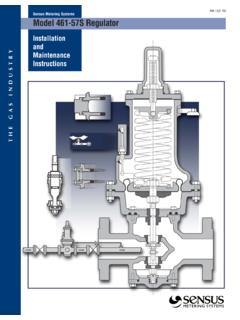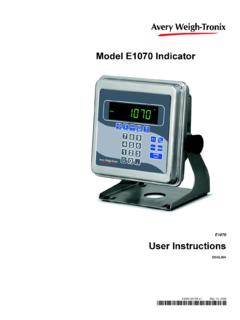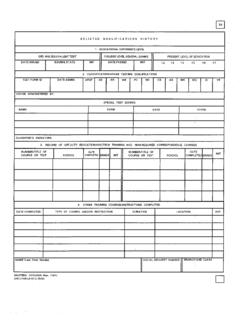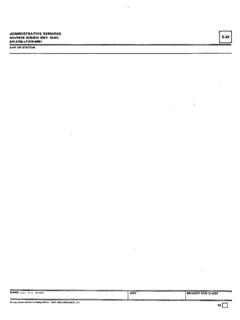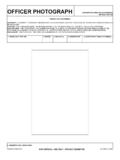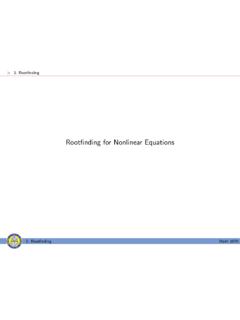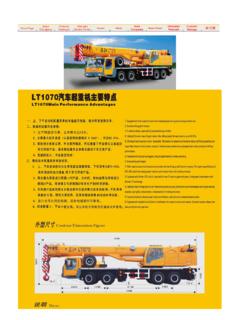Transcription of MM-1070 R9 Sensus Metering Systems Turbo-Meters …
1 MM-1070 R9 Sensus Metering SystemsInstallation andMaintenanceInstructionsTurbo- meters Mark-II and Auto-Adjust THE GAS INDUSTRY2 Installation and Maintenance InstructionsMark-II and Auto-Adjust Sensus Metering Systems Turbo-Meters are designed for the measurement of gas. Proper application and routine maintenance will result in many years of active service life. The following instructions are in general conformance with the recommendations contained in American Gas Association,Gas Measurement Committee Report #7, Measurement of Gas by Turbine meters . 5 NominalPipe Diameters8 Pipe Diameters(see note)10 NominalPipe Diameters5 NominalPipe DiametersOptionalStraighteningVanesInlet GasTurbineMeterTemperatureWellBlowDownOn ReceiptCarefully examine the shipping container for any external damage prior to unpacking. Any evident damage should be reported to the unpacking the meter, examine it for compliance with your ordering specifications. Report any deviations to your Sensusrepresentative.
2 RETAIN ALL DOCUMENTS SHIPPED WITH THE METER SINCE THESE ARE REQUIRED FOR METER SpecificationsMark-II and Auto-Adjust Turbo-Meters all use the same meter bodies, with flange dimensions conforming to ANSI standards. All turbo -Meter bodies are hydrostatically tested at a minimum of times the maximum rated working pressure indicated on themeter body badge. The maximum rated working pressure stampedon the meter body badge must not be exceeded in service. Standard construction aluminum, ductile iron and steel bodied Turbo-Meters will operate over a flowing gas temperature range of -20 F to + 165 F ( C to + 74 C). Special construction isavailable for lower and higher operating are basically velocity sensing devices which derive volume by sensing the flow rate through the known cross-sectional area of the measuring module. Accurate velocity sensingis essential in deriving accurate volume measurement. Accessory devices in close proximity to the turbo -Meter set can cause a jetting or swing condition, upsetting the normal velocityprofile of the gas stream.
3 Extensive tests of Turbo-Meters at various flow rates and pressures have defined the recommendedpiping installations which should result in optimal volume measurement accuracy. The most common installations are as follows:1. InlineA minimum run of ten (10) pipe diameters (DN) of straight pipe must be used between any flow-altering device (other than flow throttling) and the inlet flange of the turbo -Meter (Figure 1). Note:A total of eighteen (18) pipe diameters must be usedbetween any throttling device (regulator, control valve, etc.)installed upstream of the meter and the meter inlet flange. This inlet pipe should be nominally the same interior diameter asthe meter body. Minor variations in the piping ID due to use of piping with different wall thickness will not affect the meter accuracy. Inline straightening vanes locate five pipe diametersupstream of the meter inlet are optional. Extensive testing in lineswith and without straightening vanes mounted in the inlet piping demonstrates no difference in accuracies when usingTurbo- meters with built in straightening Assembly4 Nominal PipeDiameters (DN)90 Elbowor TeeMaximumReductionOne NominalPipe SizeGas TurbineMeterTemperatureWellStandardorRed ucingElbowor TeeSpace for Valving2 NominalPipe DiametersSpace for Valving,Filter or Strainer90 Standard orLong Radius ElbowMinimumInletStraighteningValvesNote :A throttling device (regulator control valve, etc.)
4 Upstream of the meter run requires a minimum of eight (8) pipe diameters(DN) between such device and the meter Off-Set, Short CoupledTurbo- meters may be installed in short-coupled sets as illustrated in Figure 2. Note that the flow-restricting devices must be installed in the vertical riser and that a 90 fitting must be used at the inlet to the meter run. This fitting may be an elbow or a tee. A straight run of pipe, equal in ID to the meter size and four diameters long, as well as equipped with straightening vanes at the inlet end, is attached to the inlet side of the 1 Recommended Installation of an In-Line Gas Turbine Meter (Minimum Lengths)Figure 2 Short Coupled Installation of an In-Line Gas Turbine Meter (Minimum Lengths)3 Installation and Maintenance InstructionsMark-II and Auto-Adjust 3. Offset, Close Coupled Sensus Turbo-Meters manufactured since October, 1974 incorporate integral straightening vanes. This design eliminates the need for long inlet runs and enablesTurbo- meters to be close-coupled as illustrated in Figure Elbowor TeeMaximumReductionOne NominalPipe SizeGas TurbineMeterTemperatureWellStandardorRed ucingElbowSpace for ValvingSpace for Valving,Filter or Strainer90 InletThe two 90 turns into the inlet end of the short or close coupledmeter runs must be in the same plane to ensure an even velocityprofile at the meter inlet.
5 The 90 turn can be accomplished witheither elbows or tees. Reducing fittings can be used. However, the maximum reductions at the inlet end are as shown in figure fittings used on the piping down-stream of the meter are notcritical except that the connection to the meter outlet flange mustbe equal in ID to the meter dimensions for Turbo-Meters are as follows:MeterMax Pressure In-LineSizeRating (PSIG)*Dimensions4"175144"HP151 26"175166"HP221 28"175218"HP271 412"2203012"HP321 2 AABBI nstallation fabrication, welding, purging and hydrostatic testing must be completed prior to installation of the turbo -Meter in installation of a by-pass line around the meter is recommended for all piping configurations (refer to figure 5.) pipe flanges at the meter inlet and outlet should be concentrically aligned with no gasket protrusion into the flow interior should be of commercial roughness with no protruding InstallationTurbo- meters may be installed in the vertical position with the meter inlet up or down.
6 To achieve adequate rotor shaft bearinglubrication, the pressurized lubrication procedure must be piping specifications on vertical installations are identical tothose detailed for horizontal installations. Although vertical installations are acceptable, Turbo-Meters in the horizontal positionare the preferred method of Connections Where low pressure or critical flow provers or transfer provers will be used to field prove Turbo-Meters , it is important to locatethe prover connections so that the normal flow pattern through the meter is duplicated. Tees, located at the meter inlet and outlet equipped with blind flanges and 2" and 3" pipe plugs can be used for this purpose. Pressure connections for instrumentation are located on the inlet ends of the meter body or the top plate. Please note that somemeters may have both a body and top plate tap. Use the top plate tap in these instances. Temperature connections for eithercorrective or recording instruments should be located downstreamwithin two pipe diameters of the meter flangeFigure 3 Closed Coupled Installations of an In-Line Gas Turbine Meter with Integral Straightening ValvesFigure 4 Maximum ReductionsAB4"3"6"4"8"6"12"8"4 Installation and Maintenance InstructionsMark-II and Auto-Adjust Blow-DownProvision for a controlled pressure blow-down of the meter run should be made.
7 The blow-down should be located between themeter outlet flange and the downstream block valve (shown in figure 5). While Turbo-Meters can be operated up to 150 percentof maximum rated capacity for short periods of time with no damaging effects, over-sized blow-downs can cause speeds greatly in excess of this amount. On inside meter sets, blow-downshould not be sized larger than one-sixth the meter size asdescribed in the following table: The recommended maximum rate of pressure change is 100 psig per minute when decreasing pressure and 67 psig per minute when increasing SizeBlow-Down Size2"1/4"3"1/2"4"1/2"6"1"8"1"12"1"Body Drain Every turbo -Meter body is supplied with a body drain plug that can be used to remove any accumulated liquids. This drain can befitted with a 1/4" valve, allowing liquids to be expelled periodicallywithout interrupting the meter Where excessively dirt gas conditions are present, a filter or strainer should be installed upstream of the turbo -Meter in the location shown in the installation drawings.
8 The maximum recommended particle size flowing through the meter should be no greater than 140 microns (typically 100 mesh strainer).Start-Up(Refer to Figure 5) C open, valves A, B and D * open valve meter stops registering, slowly open valve valve C.*Slowly is defined as a flow rate change from 0 ACFH to 100% in not less than 30 seconds. This is also a linear relationship for valve Assembly4 Pipe Diameters LongInletStraighteningVanesBlow-DownValv eDBlockValveBStandardor ReducingElbowsBlockValveABlockValveCBy Pass LineOn high pressure installations, a valved bypass around the inletriser block valve ( A in Figure 5) is recommended. Usually constructed of 3/4" pipe, with a needle-type valve, the by-pass permits pressurizing of the meter run without damaging the meter. Once the inlet pressure has been achieved, as indicated by lack of any registration on the meter, the needle valve is closed andSteps #2, #3 and #4 in start-up procedure should be Down(Refer to Figure 5) Valve close valve close valve open valve DNote on Bypass LinesIf a bleed-to-line pilot loaded pressure regulator is installed upstream of the meter, the control line must also be attachedupstream of the meter.
9 Installation of the control line downstreamof the meter constitutes a bypass which can result in significant volumes of unmetered gas at elevated 5 FirstPumpSecond PumpThird PumpFourth andAdditional PumpsHold Lubricating Gun In This Position When Lubricating MeterPart Number 006-24-400-00000 Protective CapLubrication ValveCouplerAlemite Fitting5 Installation and Maintenance InstructionsMark-II and Auto-Adjust LubricationCAUTIONThe lubrication system is subject internally to full line pressure. Follow the procedures as detailed to prevent blowing gas to the atmosphere. ALWAYS leave the lubricating system valve closed except when actually lubricating the meter. NEVER use the lubrication system to blowdown pressure in the meter. Doing so will force any line contaminants directly into the bearings. NEVER attach static pressure lines from either recording or integrating gauges to the lubrication rotor shaft bearings MUST be lubricated prior to putting the meter into service, using the approved turbo -Meter oil shipped with the meter.
10 The most effective lubrication procedure for a turbo -Meter is the pressure method which provides positive lubrication and flushing of the rotor shaft bearings by use of a manual pressure method should always be utilized for the Auto-Adjust Turbo-Meters to ensure proper lubrication to both the main and sensing rotor pressure method is also the recommended method for the Mark-II , an optional gravity feed or automated lubrication equipment can be used with the Mark-II Turbo-Meters . It is also recommended to periodically add a drop or two of oil to the top of the follower magnet assembly, located in the unpressurized gear box under the intermediate gear train ProcedureA. Pressure protective cap from the lubrication fitting (See Figure 6). Open lubrication valve and check for leakage through the ball-check in the Alemite fitting. If the fitting leaks,close the valve and replace the fitting prior to lubricating the the lubrication handgun handle to either the Volume or Pressure setting by sliding the button on the pump handle.
